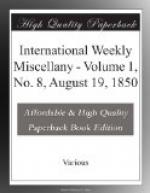* * * * *
Mr. SEBA SMITH, so well known as the author of the “Letters of Major Jack Downing,” and to a different sort of readers for his more serious contributions to our literature, has just completed the printing of an original and very remarkable work, upon which he has been engaged about two years, entitled “New Elements of Geometry,” and it will soon be published in this city by Putnam, and in London by Bentley. It will probably produce a sensation in the world of science. Its design is the reconstruction of the entire methods of Geometry. All geometers, from the dawn of the science, have built their systems upon these definitions: A line is length without breadth, and A surface is length and breadth, without thickness. Mr. Smith asserts that these definitions are false, and sustains his position by numerous demonstrations in the pure Euclidean style. He declares that every mathematical line has a definite breadth, which is as measurable as its length, and that every mathematical surface has a thickness, as measurable as the contents of any solid. His demonstrations, on diagrams, seem to be eminently clear, simple, and conclusive. The effects of this discovery and these demonstrations are, to simplify very much the whole subject of Geometry and mathematics, and to clear it of many obscurities and difficulties. All geometers heretofore have claimed that there are three kinds of quantity in Geometry, different in their natures, and requiring units of different natures to measure them. Mr. Smith shows that there is but one kind of quantity in Geometry, and but one kind of unit; and that lines, surfaces, and solids are always measured by the same identical unit.
Besides the leading features of the work which we have thus briefly described, it contains many new and beautiful demonstrations of general principles in Geometry, to which the author was lead by his new methods of investigation. Among these we may mention one, viz., “The square of the hypothenuse of a right-angled triangle equals four times the area of the triangle, plus the square of the difference of the other two sides.” This principle has been known to mathematicians by means of arithmetic and algebra, but has never before, we believe, been reduced to a geometrical demonstration. The demonstration




